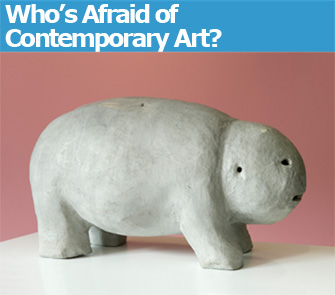 |
|
“Animal” (1986) by Fischli & Weiss. |
A friend told me the other day that he didn’t like contemporary art. But what is contemporary art? It is simply art being made today or made in the recent past, so in theory it could be …
 |
|
“Animal” (1986) by Fischli & Weiss.
|
A friend told me the other day that he didn’t like contemporary art. But what is contemporary art? Just art being made today or made in the recent past, so it could be anything, making a blanket condemnation of it seem rather absurd.
The current exhibition at the Maison Rouge, “Les Recherches d’un Chien” (through January 16, 2011), shows that there are many things to like about contemporary art and offers a nice survey of trends by presenting a selection of works from the collections of five European contemporary art foundations*, which have joined forces and formed a group called FACE (Foundation of Arts for a Contemporary Europe).
The exhibition’s title refers to Kafka’s 1922 story “Investigations of a Dog,” written from the point of view of a dog who is questioning the meaning of his canine identity. The works are meant to comment on the role of the individual vis-à-vis society at large and the political world (a vast simplification of the catalog’s pedantic introduction), but there is no need to know this to enjoy the show.
The show starts off strongly with “Animal” (1986) by Fischli & Weiss. This gray statue of a generic animal looks like a stripped-down hippo, with holes in all the right places but no other features standing out on its smooth surface. It manages to be adorable and creepy at the same time, and immediately calls to mind that famous (and much more colorful) Eygptian statuette of a hippo belonging to the Metropolitan Museum of Art whose reproduction is a staple of museum gift shops.
Other powerful animal-themed pieces come up in the next room: Mark Dion’s “Les Nécrophores-L’Enterrement (Hommage à Jean-Henri Fabre) (1997), involves a gigantic and very realistic dead mole strung up by a rope from the ceiling (Wind on the Willows fans look away now), with two proportionately enormous beetles crawling on its back, prepared to devour it. Nearby lies Paul McCarthy’s lifelike and life-sized brown “Pig” (2003), not as fascinating as the artist’s animated pink version of the sleeping sow I once saw, but still very impressive in its weighty massiveness.
One piece that particularly struck me was “The View from Bed” (2007) by DeAnna Maganias, a massive, smooth-surfaced white cube with a corner cut away. When you peek inside, you see a mysterious empty room with light coming through a window and a door ajar. In one of the many nice echos in this well-curated exhibition, it complements Gregor Schneider’s “Das Grosse Wichsen” (1997), a large packing case, all rough and dirty, in contrast to Maganias’s smooth white container. When you look inside Schneider’s piece, you vaguely see some miscellaneous objects through a murky, half-curtained glass wall. Both of these enigmatic pieces give you a sense of having glimpsed something special that you can’t quite grasp.
The show also includes one of Willian Kentridge’s transfixing videos, “The Main Complaint” (1996). Complex, poetic and grim, it is also funny, with ever-multiplying numbers of doctors surrounding a sick man’s bed and applying stethosopes to various parts of his body through the bedclothes (and the man’s suit, which he is wearing in the hospital bed).
Among the many other pieces I liked were three photos by Annika von Hausswolff, each of which treats the subject of women with dark, wry humor. A depiction of a dead naked woman floating face down in swampy waters, for example, is gruesome and sexually suggestive until the title, “Tillbaka till Naturen/Back to Nature” lets you see it from another perspective.
The work of von Hausswolff (and many of the other artists) was a discovery to me, another good reason to see this show, which also includes pieces by big names like Maurizio Catelan, Thomas Hirschhorn and Martin Parr (a wall covered with dozens of his witty images; take the time to look at them individually for major gross-out laughs).
I think I can safely recommend this show even to contemporary-artophobics.
La Maison Rouge: 10, boulevard de la Bastille, 75012 Paris. Métro: Quai de la Rapée or Bastille. Tel.: 40 01 08 81. Open Wednesday-Sunday, 11 a.m.-7 p.m. (until 9 p.m. on Thursday. Admission: €7. Through January 16. www.lamaisonrouge.org
* DESTE Foundation, Athens; Ellipse Foundation, Cascais, Portugal; Fondazione Sandretto Re Rebaudengo, Turin, Italy; Magasin 3, Stockholm; Fondation Antoine de Galbert, Paris.
Support Paris Update by ordering books from Paris Update’s Amazon store at no extra cost. Click on your preferred Amazon location: U.K., France, U.S.
Reader Reaction: Click here to respond to this article (your response may be published on this page and is subject to editing).
More reviews of Paris art shows.
© 2010 Paris Update
Favorite